The AnandTech Coffee Lake Review: Initial Numbers on the Core i7-8700K and Core i5-8400
by Ian Cutress on October 5, 2017 9:00 AM EST- Posted in
- CPUs
- Intel
- Core i5
- Core i7
- Core i3
- 14nm
- Coffee Lake
- 14++
- Hex-Core
- Hyperthreading
Ashes of the Singularity Escalation
Seen as the holy child of DirectX12, Ashes of the Singularity (AoTS, or just Ashes) has been the first title to actively go explore as many of DirectX12s features as it possibly can. Stardock, the developer behind the Nitrous engine which powers the game, has ensured that the real-time strategy title takes advantage of multiple cores and multiple graphics cards, in as many configurations as possible.
As a real-time strategy title, Ashes is all about responsiveness during both wide open shots but also concentrated battles. With DirectX12 at the helm, the ability to implement more draw calls per second allows the engine to work with substantial unit depth and effects that other RTS titles had to rely on combined draw calls to achieve, making some combined unit structures ultimately very rigid.
Stardock clearly understand the importance of an in-game benchmark, ensuring that such a tool was available and capable from day one, especially with all the additional DX12 features used and being able to characterize how they affected the title for the developer was important. The in-game benchmark performs a four-minute fixed seed battle environment with a variety of shots, and outputs a vast amount of data to analyze.
For our benchmark, we run a fixed v2.11 version of the game due to some peculiarities of the splash screen added after the merger with the standalone Escalation expansion, and have an automated tool to call the benchmark on the command line. (Prior to v2.11, the benchmark also supported 8K/16K testing, however v2.11 has odd behavior which nukes this.)
At both 1920x1080 and 4K resolutions, we run the same settings. Ashes has dropdown options for MSAA, Light Quality, Object Quality, Shading Samples, Shadow Quality, Textures, and separate options for the terrain. There are several presents, from Very Low to Extreme: we run our benchmarks at Extreme settings, and take the frame-time output for our average, percentile, and time under analysis.
All of our benchmark results can also be found in our benchmark engine, Bench.
MSI GTX 1080 Gaming 8G Performance
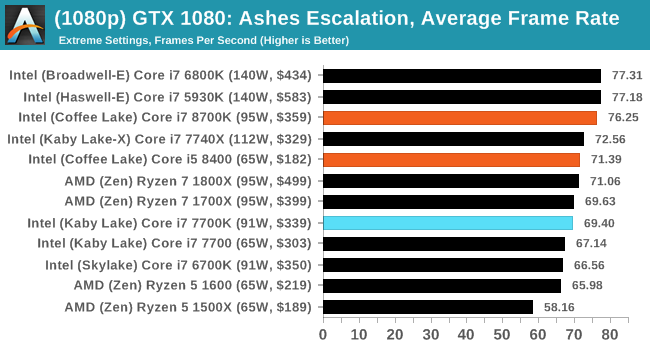
1080p

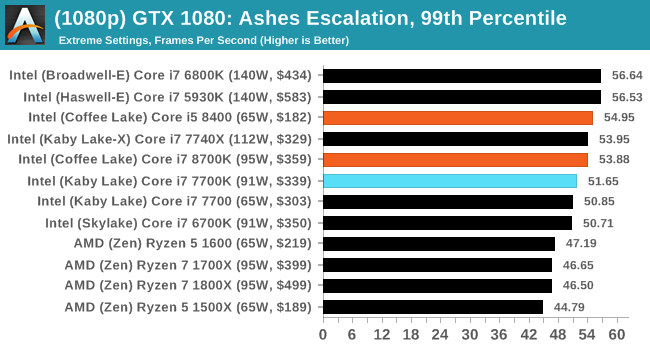
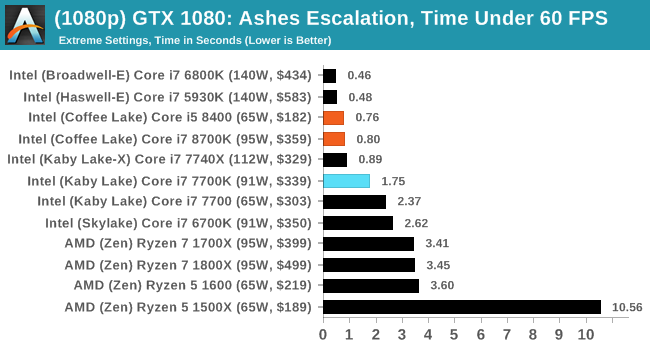
4K
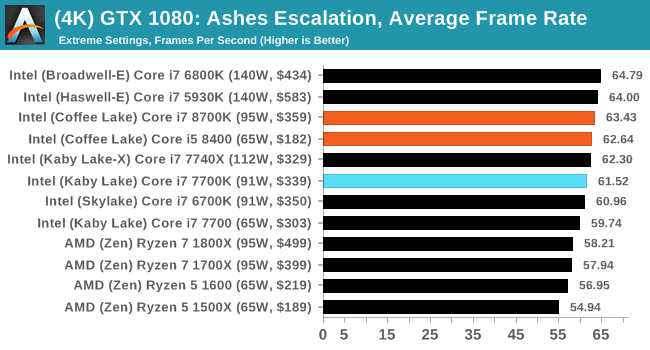
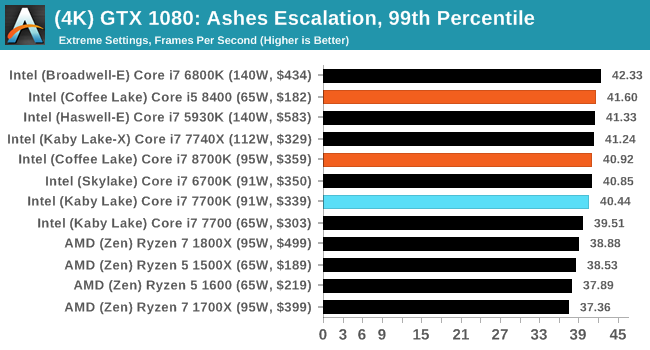




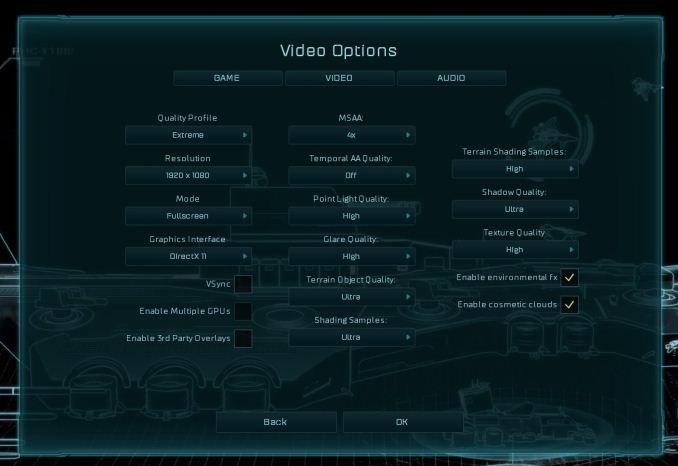








222 Comments
View All Comments
mkaibear - Saturday, October 7, 2017 - link
Well, I'd broadly agree with that!There are latency issues with that kind of approach but I'm sure they'd be solvable. It'll be interesting to see what happens with Intel's Mesh when it inevitably trickles down to the lower end / AMD's Infinity Fabric when they launch their APUs.
mapesdhs - Tuesday, October 10, 2017 - link
Such an idea is kinda similar to SGI's shared memory designs. Problem is, scalable systems are expensive, and these days the issue of compatibility is so strong, making anything new and unique is very difficult, companies just don't want to try out anything different. SGI got burned with this re their VW line of PCs.boeush - Saturday, October 7, 2017 - link
I think it's a **VERY** safe bet that most systems selling with an i7 8700/k will also include some sort of a discrete GPU. It's almost unimaginable that anyone would buy/build a system with such a CPU but no better GPU than integrated graphicsWhich makes the iGPU a total waste of space and a piece of useless silicon that consumers are needlessly paying for (because every extra square inch of die area costs $$$).
For high-end CPUs like the i7s, it would make much more sense to ditch the iGPU and instead spend that extra silicon to add an extra couple of cores, and a ton more cache. Then it would be a far better CPU for the same price.
So I'm totally with the OP on this one.
mkaibear - Sunday, October 8, 2017 - link
You need a better imagination!Of the many hundreds of computers I've bought or been responsible for speccing for corporate and educational entities, about half have been "performance" oriented (I'd always spec a decent i5 or i7 if there's a chance that someone might be doing something CPU limited - hardware is cheap but people are expensive...) Of those maybe 10% had a discrete GPU (the ones for games developers and the occasional higher-up's PC). All the rest didn't.
From chatting to my fellow managers at other institutions this is basically true across the board. They're avidly waiting for the Ryzen APUs to be announced because it will allow them to actually have competition in the areas they need it!
boeush - Sunday, October 8, 2017 - link
It's not surprising to see business customers largely not caring about graphics performance - or about the hit to CPU performance that results from splitting the TDP budget with the iGPU...In my experience, business IT people tend to be either penny-wise and pound-foolish, or obsessed with minimizing their departmental TCO while utterly ignoring company performance as a whole. If you could get a much better-performing CPU for the same money, and spend an extra $40 for a discrete GPU that matches or exceeds the iGPU's capabilities - would you care? Probably not. Then again, that's why you'd stick with an i5 - or a lower-grade i7. Save a hundred bucks on hardware per person per year; lose a few thousand over the same period in wasted time and decreased productivity... I've seen this sort of penny-pinching miscalculation too many times to count. (But yeah, it's much easier to quantify the tangible costs of hardware, than to assess/project the intangibles of sub-par performance...)
But when it comes specifically to the high-end i7 range - these are CPUs targeted specifically at consumers, not businesses. Penny-pinching IT will go for i5s or lower-grade i7s; large-company IT will go for Xeons and skip the Core line altogether.
Consumer builds with high-end i7s will always go with a discrete GPU (and often more than one at a time.)
mkaibear - Monday, October 9, 2017 - link
That's just not true dude. There are a bunch of use cases which spec high end CPUs but don't need anything more than integrated graphics. In my last but-one place, for example, they were using a ridiculous Excel spreadsheet to handle the manufacturing and shipping orders which would bring anything less than an i7 with 16Gb of RAM to its knees. Didn't need anything better than integrated graphics but the CPU requirements were ridiculous.Similarly in a previous job the developers had ludicrous i7 machines with chunks of RAM but only using integrated graphics.
Yes, some it managers are penny wise and pound foolish, but the decent ones who know what they're doing they spend the money on the right CPU for the job - and as I say a serious number of use cases don't need a discrete GPU.
...besides it's irrelevant because the integrated GPU has zero impact on performance for modern Intel chips, as I said the limit is thermal not package size.
If Intel whack an extra 2 cores on and clock them at the same rate their power budget is going up by 33% minimum - so in exchange for dropping the integrated GPU you get a chip which can no longer be cooled by a standard air cooler and has to have something special on there, adding cost and complexity.
Sticking with integrated GPUs is a no-brainer for Intel. It preserves their market share in that environment and has zero impact for the consumer, even gaming consumers.
boeush - Monday, October 9, 2017 - link
Adding 2 cores to a 6-core CPU drives the power budget up by 33% if and **ONLY IF** all cores are actually getting fully utilized. If that is the case, then the extra performance from those extra 2 cores would be indeed actually needed! (at least on those occasions, and would be, therefore, sorely missed in a 6-core chip.). Otherwise, any extra cores would be mostly idle, not significantly impacting power utilization, cooling requirements, or maximum single-thread performance.Equally important to the number of cores is the amount of cache. Cache takes up a lot of space, doesn't generate all that much heat (compared to the actual CPU pipeline components), but can boost performance hugely, especially on some tasks that are memory-constrained. Having more L1/L2/L3 cache would provide a much better bang for the buck when you need the CPU grunt (and therefore a high-end i7), than the waste of an iGPU (eating up ~50% of die area) ever could.
Again, when you're already spending top dollar on an i7 8700/k (presumable because you actually need high CPU performance), it makes little sense that you go, "well, I'd rather have **LOWER** CPU performance, than be forced to spend an extra $40 on a discrete GPU (that I could then reuse on subsequent system builds/upgrades for many years to come)"...
mkaibear - Tuesday, October 10, 2017 - link
Again, that's not true. Adding 2 cores to a 6 core CPU means that unless you find some way to prevent your OS from scheduling threads on it then all those cores are going to end up used somewhat - which means that you have to plan for your worst case TDP not your best case TDP - which means you have to engineer a cooling solution which will work for the full 8 core CPU, increasing costs to the integrator and the end user. Why do you think Intel's worked so hard to keep the 6-core CPU within a few watts of the old 4-core CPU?In contrast an iGPU can be switched on or off and remain that way, the OS isn't going to assign cores to it and result in it suddenly dissipating more power.
And again you're focussing on the extremely limited gamer side of things - in the real world you don't "reuse the graphics card for many years to come", you buy a machine which does what you need it to and what you project you'll need it to, then replace it at the end of whatever period you're amortising the purchase over. Adding a $40 GPU and paying the additional electricity costs to run that GPU over time means your TCO is significantly increased for zero benefits, except in a very small number of edge cases in which case you're probably better off just getting a HEDT system anyway.
The argument about cache might be a better one to go down, but the amount of cache in desktop systems doesn't have as big an impact on normal workflow tasks as you might expect - otherwise we'd see greater segmentation in the marketplace anyway.
In short, Intel introducing desktop processors without iGPUs makes no sense for them at all. It would benefit a small number of enthusiasts at a cost of winding up a large number of system integrators and OEMs, to say nothing of a huge stack of IT Managers across the industry who would suddenly have to start fitting and supporting discrete GPUs across their normal desktop systems. Just not a good idea, economically, statistically or in terms of customer service.
boeush - Tuesday, October 10, 2017 - link
The TDP argument as you are trying to formulate it is just silly. Either the iGPU is going to be in fact used on a particular build, or it's going to be disabled in favor of headless operation or a discrete GPU. If the iGPU is disabled, then it is the very definition of all-around WASTE - a waste of performance potential for the money, conversely/accordingly a waste of money, and a waste in terms of manufacturing/materials efficiency. On the other hand, if the iGPU is enabled, it is actually more power-dense that the CPU cores - meaning you'll have to budget even more heavily for its heat and power dissipation, than you'd have for any extra CPU cores. So in either case, your argument makes no sense.Remember, we are talking about the high end of the Core line. If your build is power-constrained, then it is not high-performance and you have no business using a high-end i7 in it. Stick to i5/i3, or the mobile variants, in that case. Otherwise, all these CPUs come with a TDP. Whether the TDP is shared with an iGPU or wholly allocated to CPU is irrelevant: you still have to budget/design for the respective stated TDP.
As far as "real-world", I've seen everything from companies throwing away perfectly good hardware after a year of use, to people scavenging parts from old boxes to jury-rig a new one in a pinch.
And again, large companies with big IT organizations will tend to forego the Core line altogether, since the Xeons provide better TCO economy due to their exclusive RAS features. The top-end i7 really is not a standard 'business' CPU, and Intel really is making a mistake pushing it with the iGPU in tow. That's where they've left themselves wide-open to attack from AMD, and AMD has attacked them precisely along those lines (among others.)
Lastly, don't confuse Intel's near-monopolistic market segmentation engineering with actual consumer demand distribution. Just because Intel has chosen to push an all-iGPU lineup at any price bracket short of exorbitant (i.e. barring the so-called "enthusiast" SKUs), doesn't mean the market isn't clamoring for a more rational and effective alternative.
mkaibear - Wednesday, October 11, 2017 - link
Sheesh. Where to start?1) Yes, you're right, if the iGPU isn't being used then it will be disabled, and therefore you don't need to cool it. Conversely, if you have additional cores then your OS *will* use them, and therefore you *do* need to cool them.
iGPU doesn't draw very much power at all. HD2000 drew 3W. The iGPU in the 7700K apparently draws 6W so I assume the 8700K with a virtually identical iGPU draws just as much (figures available via your friendly neighbourhood google). Claiming the iGPU has a higher power budget than the CPU cores is frankly ridiculous. (in fact it also draws less than .2W when it's shut down which means that having it in there is far outweighed by the additional thermal sink available, but anyway)
2) Large companies with big IT organisations don't actually forego the Core line altogether and go with Xeons. They could if they wanted to, but in general they still use off-the shelf Dells and HPs for everything except extremely bespoke setups - because, as I previously mentioned, "hardware is cheap, people are expensive" - getting an IT department to build and maintain bespoke computers is hilariously expensive. No-one is arguing that for an enthusiast building their own computer that the option of the extra cores would be nice, but my point all along has been that Intel isn't going to risk sacrificing their huge market share in the biggest market to gain a slice of a much smaller market. That would be extremely bad business.
3) The market isn't "clamoring for a more rational and effective alternative" because if it was then Ryzen would have flown off the shelves much faster than it did.
Bottom line: business IT wants simple solutions, the fewer parts the better. iGPUs on everything fulfil far more needs than dGPUs for some and iGPUs for others. iGPUs make designing systems easier, they make swapouts easier, they make maintenance easier, they reduce TCO, they reduce RMAs and they just make IT staff's lives easier. I've run IT for a university, a school and a manufacturing company, and for each of them the number of computers which needed a fast CPU outweighed the number of computers which needed a dGPU by a factor of at least 10:1 - and the university I worked for had a world-leading art/media/design dept and a computer game design course which all had dGPUs. The average big business has even less use for dGPUs than the places I've worked.
If you want to keep trying to argue this then can you please answer one simple question: why do you think it makes sense for Intel to prioritise a very small area in which they don't have much market share over a very large area in which they do? That seems the opposite of what a successful business should do.